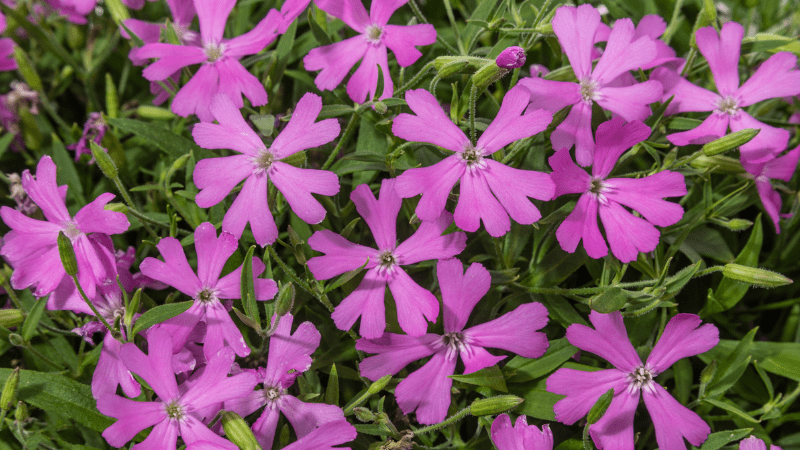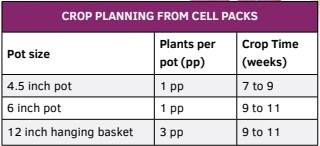
Culture Report: Silene Carol Jean Series
We have become complacent with ground cover that supplies the landscape with little more than taking space. Classic options of ivy, pachysandra and the like show little more than a green mat that may fill a void but does not provide interest.
Over the past several years Green Fuse Botanicals has bred options to break the “norm” in this dated category. Beginning in the 2023-24 season, an all new program will be available to the growers and consumers throughout North America with the Endless Ground Color assortment. The emphasis is clearly on “color.” The breeding program set forth to provide zone hardy ground covers that also provide day-length neutral flowering for the entire growing season.
The program includes a wide range of genus from leucanthemum ‘Carpet Angel’ — the world’s first groundcover shasta and an All-America Selections winner — to the gazania Sterling Silver series with soft silver foliage and fully double blossoms that remain open through the night. For this article, we will focus on an extremely underutilized perennial that performs coast to coast — silene.
Silene is a genus of plant that encompasses 900 species. Native habitats range from high altitude alpine climates to lowland swamps. While it is predominantly found wild in the Northern hemisphere, silene is dispersed throughout the world. Named after the Greek God of the woodlands, silene has been used as an ornamental as well as a culinary ingredient for hundreds, if not thousands of years. Its use as a groundcover has just begun.

Green Fuse Botanicals has introduced the silene Carol Jean series into the Endless Ground Color collection since it clearly checks all the boxes of both grower and consumer success. Available in both a clear deep pink and true white, the Carol Jean series blooms profusely every single day of the growing season. While it is completely day-length neutral, the Carol Jean series requires an average daily temperature above 62° F to initiate flowering.
This actually times quite well for retail, as the Carol Jean silene comes into color naturally almost exactly when Phlox subulata stops flowering in mid-spring. This has positioned the silene as the “summer subulata.” Flowering all season whether in the high, dry mountains of the west or the low, humid regions of the southwest, Carol Jean will be successful.
 Silene Carol Jean will produce a mature height of 3 to 5 inches in the landscape while pushing a width of 24 to 30 inches. Deep green foliage has been known to be an evergreen in climates above USDA Zone 6. In cooler zones, it will die completely back until the following growing season.
Silene Carol Jean will produce a mature height of 3 to 5 inches in the landscape while pushing a width of 24 to 30 inches. Deep green foliage has been known to be an evergreen in climates above USDA Zone 6. In cooler zones, it will die completely back until the following growing season.
As we move into a new production season, it is key that we support our end consumer with options that promote garden success. We may look to provide focus on the reinvigoration of classic categories, ground cover being among the largest. The Endless Ground Color collection will not only provide new options for border plantings, but most importantly color for our pathways ahead.
PRODUCTION SEASONS
Spring and summer
CUSTOMER USE
Landscapes, rock gardens and groundcover
NOTES
The Carol Jean series performs best in high heat is day-length neutral and requires no vernalization.
USDA HARDINESS ZONE
5–10
PROPAGATION
Silene unrooted cuttings will be delivered as a single node and stem. The node must make media contact in order to root. Media temperature of 70 to 72° F and relative humidity above 85% is ideal for consistency. K-IBA foliar may be used to hasten rooting as the genus responds quite well to the hormone. Time in propagation will be 14 to 17 days. After this, it may be moved to a cooler zone maintaining an average daily temperature of 60° F.
FINISHING CULTURE
Silene prefers even moisture, severe dry down will cause bud abortion. Maintain a pH of 6.2 to 7.2.
FERTILIZER REQUIREMENTS
100 to 125 ppm Nitrogen using a balanced feed to maintain color of foliage. Include micro element source as part of fertilizer solution. Soil should be consistently moist for best performance during the growing season and well drained during winter cold temperatures. Calcium and potassium based fertilizers are ideal for quality plant growth.
TEMPERATURE REQUIREMENTS
Temperatures at 50° to 65° F at night and 65° to 75° F during the day. Silene will tolerate a wide range of temperatures and will grow well in temperatures as high as 105° F. Cooler night temperatures will delay flowering.
PINCHING REQUIREMENTS
The series is well-branched and naturally compact but must be pinched once to break apical dominance. Soft pinch rooted cuttings, leaving 4 to 5 nodes at transplant or shortly after transplanting into final containers.
GROWTH REGULATORS
High light levels are the best control of petiole height. B-9 is the most economical PGR, spray at 1,500 to 2,500 ppm. They will respond to Bonzi and Sumagic. Use at labeled rates.
PESTS/DISEASE
Spider mites, slugs, whiteflies and caterpillars are common pests to watch for. Rhizoctonia and pythium are of primary concern. Preventative drenches/sprays are recommended for silene.
For an enhanced reading experience, view this article in our digital edition by clicking here.








 Video Library
Video Library 

















